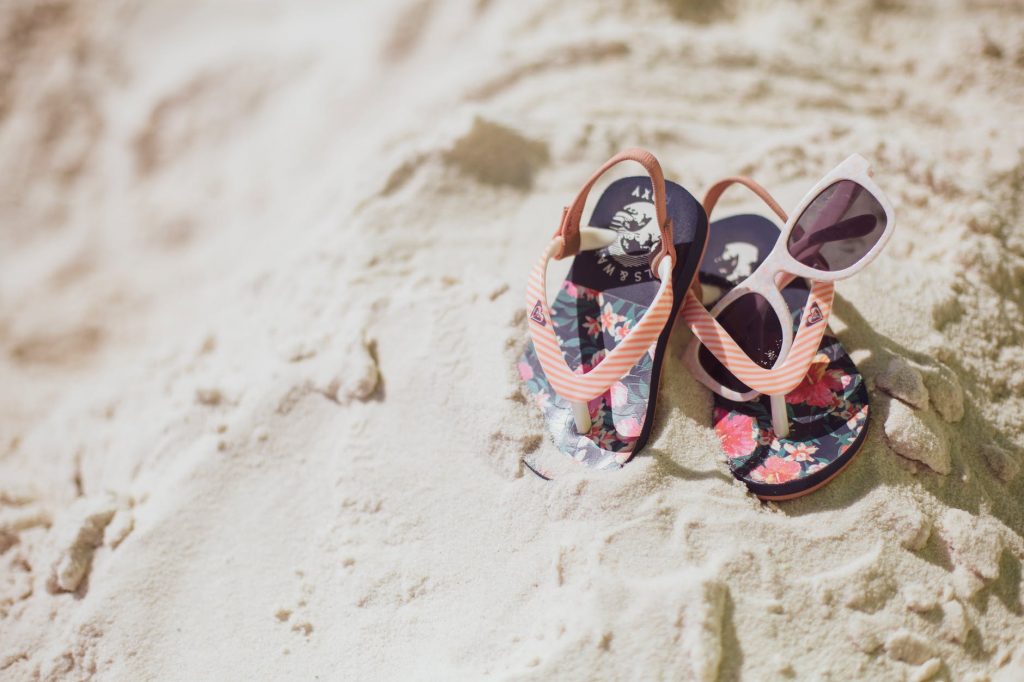
As the days start to heat up they usher in the season of shorts, scraped knees, and the need for a solid sun protection routine for your family. It’s a crucial part of summer months that cannot be overlooked. These days a good bottle of sunscreen is only the start!
The chance of developing melanoma, the most severe – and sometimes deadly—form of skin cancer doubles if you’ve had more than five sunburns, according to The National Council on Skin Cancer Prevention (NCSCP). As someone who grew up on the Carolina coast and was diagnosed with melanoma at age 21, I can confidently say skimping on sun protection is not worth the cost to you, or your child’s, body. There are more skin cancer cases diagnosed each year than breast, prostate, lung and colon cancer diagnoses combined. This is a very scary fact; however, the good news is this is a very preventable cancer.
Kids often model what their caregivers are doing, so it’s crucial for caregivers to be both good examples and advocates for children when it comes to sun protection. Parents can help little ones understand sunburns are the painful consequence of not keeping your skin safe. Much in the same way children learn to wear a bicycle helmet to protect their heads, they can also be taught to wear wide-brimmed hats and sunscreen to protect their skin. Parents can encourage kids to wear protective gear by making it fun and allowing them to select their own sun hats, shirts and sunglasses. Sun protection clothing now comes in a variety of styles, so much so that you can’t even tell it’s specially designed to protect skin. Clothing with a UPF of 30 or higher will provide the best protection.
It’s very important to select the right sunscreen. Mineral sunscreens like zinc oxide and titanium dioxide work by reflecting the sun’s rays and don’t require the absorption of chemicals into the skin to be effective. This is especially important for children who may have sensitive skin or allergies, or if your family is living a more natural lifestyle. If you choose a traditional lotion or spray sunscreen, follow the instructions on the bottle, and don’t forget to thoroughly rub it in! All sunscreens work best if you apply it 30 minutes before going outside and re-apply every two hours or after swimming. If you make sunscreen application a step that’s required before leaving the house, children are likely to accept it as part of the daily routine, just like brushing their teeth.
Parents need to show older children the proper way to apply (and reapply) sunscreen, making sure they use the full ounce recommended for complete protection. Send sunscreen, hats and UPF rated protective clothing to school, sports and summer camp with your children. Ask their caregivers to help reapply sunscreen before recess or after swimming, and make sure your children wear hats. It may be a bit of an inconvenience to teachers or counselors to give your child a few extra minutes of attention, so it may be worth having a face to face conversation with caregivers to advocate for your child’s skin. The sun can do the most damage to skin between the hours of 10 a.m. and 4 p.m., which is a time when some parents aren’t directly caring for their children. That makes it even more important to help caregivers understand how important sun safety is.
It is also equally important to know sunscreen is not recommended for children under six months old. Their skin hasn’t yet developed melanin which is the skin pigment that naturally protects the skin from sun. It’s crucial to protect the youngest babies by using hats, UPF clothing and keeping them indoors during the time when the sun can do the most damage.
I’ve had well-meaning people tell me people with darker pigmented skin don’t need to worry about skin protection as much as people with lighter skin. This is a complete myth. According to the National Council on Skin Cancer Prevention, people with darker skin are less likely to develop skin cancer, however when they do, they are more likely to be diagnosed at a later stage and have worse outcomes.
The Nation Council on Skin Cancer Prevention is sponsoring national “Don’t Fry Day” later this month on Friday the 24th. It’s a day to bring awareness to sun safety during what is largely considered the kick-off to summer – Memorial Day Weekend. Here in the Carolinas, the weather has been summer-like for weeks, but if you haven’t already started thinking about how to protect your family’s skin, it’s not too late to take the first steps.
Here’s the bottom line, if you have skin, you need to protect it when you are outdoors. Whether at the park, pool or amusement park, it’s important to remember to pause and take a few moments for sun safety.


